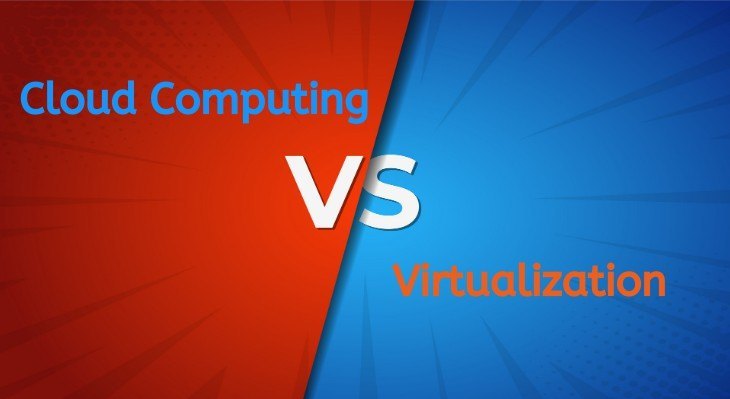For a business to thrive, it needs to be up to date with up and coming innovations in the market. Agility in collecting, processing, and storing information is the need of the hour, and the only way to meet this prerequisite is with the help of relevant technologies.
Within a corporate IT environment, there are several technical terms and many of them still create confusion for many people.
Although the terms virtualization and cloud computing are used across multiple industries, many companies are still confused and don’t know how to differentiate one from another.
To help you understand what is really behind these two terminologies, we’ve prepared this article. To better understand the difference between cloud computing and virtualization, let’s read below.
The main concept of cloud computing is the remote use of applications and features that are commonly used on a computer over the internet.
Both data storage and server processing can be done from anywhere, everything being available on virtual servers. It is possible to have a complete data center in another environment fully accessible via the internet.
Cloud computing is today a strong trend for large companies and corporations due to the possibility of the economy, especially with large structures.
The vendor is responsible for the tool and all of its tasks such as development, storage, maintenance, upgrade, and backups make it easy for the user to access without any worries, and there is no need for the company to move a team to take care only of this sector.
This technological process can be summarized in the action of software that creates a virtual infrastructure for a physical structure. It is a solution that enables you to run more than one operating system and different applications simultaneously on the same machine.
An entire operating system, or just part of it, is capable of running within another system. This technology has reduced IT costs and helped improve efficiency.
Virtualization technology is used to develop more logical servers than physical servers, which makes administration easier, reduces the cost of acquiring physical servers and hosting infrastructure, and reduces maintenance, which also generates savings for the company.
Cloud computing makes life easier for users and IT managers. No wonder that this technology has moved from a trend to a concrete reality in a few years, being used in the market in all segments.
Let’s see what benefits have made this kind of innovative service so inviting:
- The computing power allows the processing of complex tasks
- Better data recovery and security
- Cloud computing makes mobile and remote work easier
- Sharing data in real-time
- Access to expensive software
- Cost reduction
- Better availability
- Optimal support for the IT infrastructure
The first and foremost benefit of virtualization is to be able to run multiple operating systems on the same physical environment. But going through a virtualized environment also brings many other benefits.
- Energy Consumption Reduction: The cost of powering and cooling the servers is a considerable expense. A server is deployed in order to stay in place for a long time. If we calculate the cost of electricity expenses of a server throughout its life, we realize that this represents a significant sum. The key objective of virtualization is to limit the number of physical servers, and thus divide the cost into electricity and air conditioning.
- Portability: Virtualization also brings a huge gain in portability. Indeed, for a physical machine, a virtual server is just a series of files.
- Licensing: Virtualization also represents advantages in terms of licensing. Indeed, Microsoft provides an offer for Windows Server licensee for virtual environments. When purchasing a corporate license, you acquire the right to install up to 4 virtual servers. In the case of a datacenter license, the number of virtual windows systems become unlimited.
- Simplified monitoring: There are many solutions to monitor servers. When we use virtualization, a single physical server is to be monitored.
- Optimization: This centralization of the structure also helps throughout the company’s management. The primary computer can perform the server role and manage many other virtual machines.
- Hardware Integration: Virtualization allows even hardware to be simulated virtually and be integrated with multiple machines simultaneously, which significantly reduces the cost of purchasing equipment that often ends up being partially used, thereby reducing power consumption as well.
The main difference between the two concepts is that virtualization refers to the manipulation of software and hardware, while cloud computing is the consequence of this process.
Practically, cloud computing is a concept created from one product, virtualization.
What causes confusion between the two terms, is that cloud computing uses virtualized products in its structure.
Cloud computing enables the business to share and make its data available to anyone, anywhere. For this, however, it uses software that has developed multiple virtual infrastructures, from a physical layer, resulting in virtualization.
While cloud computing ensures reduced system architecture costs and ease for customers, virtualization provides infrastructure-related facilities, ensuring that very large structures – which would have been otherwise largely lost.
Virtualization can, therefore, be considered a product as it is possible to purchase solutions through software. Cloud computing is an IT architecture concept.
However, the services offered by the cloud are fully correlated with virtualization for software solutions as well as mobile environments.
Because they have very interconnected and extensive concepts, it is necessary to analyze each technology so that it is not confusing and to understand what are the purposes and needs of the companies that each one serves.
You may also like to read:
Application Virtualization in Cloud Computing: Working, Role & Tools
Fog Computing vs. Cloud Computing: What’s the Difference?

